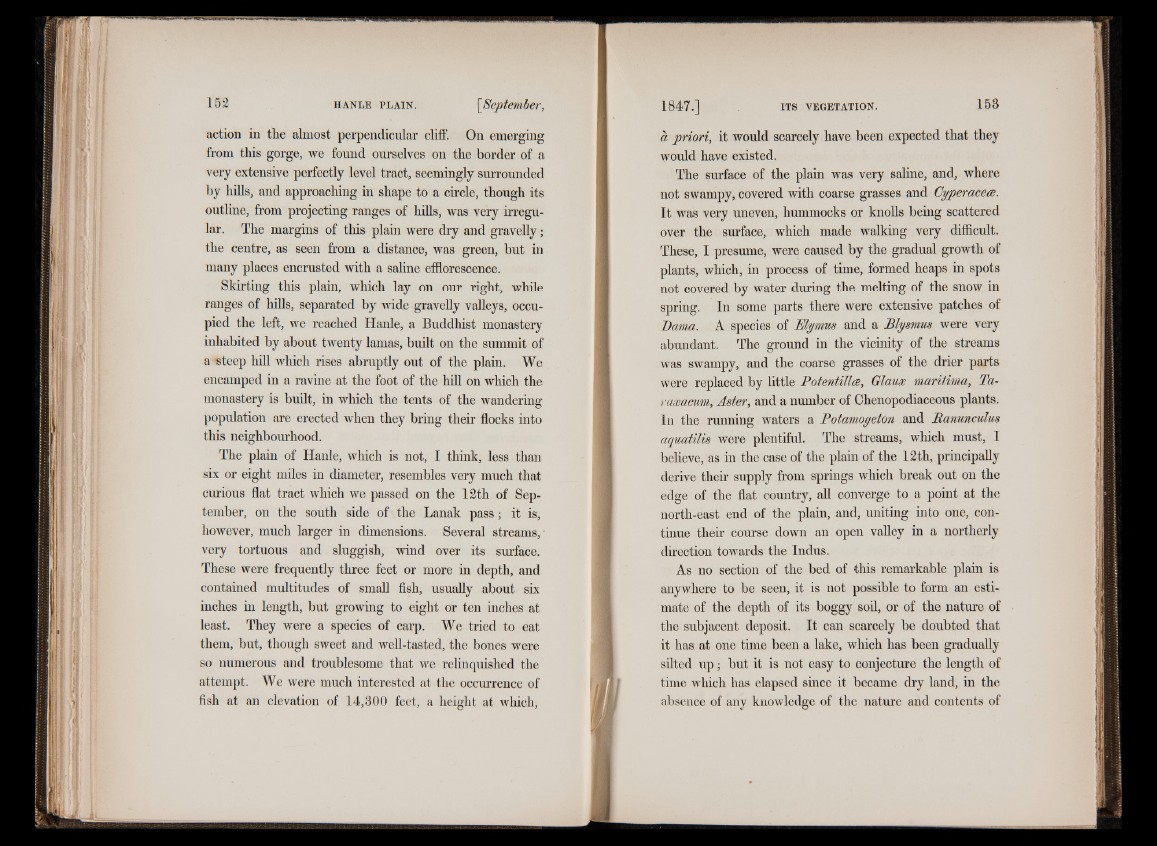
action in the almost perpendicular cliff. On emerging
from this gorge, we found ourselves on the border of a
very extensive perfectly level tract, seemingly surrounded
by hills, and approaching in shape to a circle, though its
outline, from projecting ranges of hills, was very irregular.
The margins of this plain were dry and gravelly;
the centre, as seen from a distance, was green, but in
many places encrusted with a saline efflorescence.
Skirting this plain, which lay on our right, while
ranges of hills, separated by wide gravelly valleys, occupied
the left, we reached Hanle, a Buddhist monastery
inhabited by about twenty lamas, built on the summit of
a -steep hill which rises abruptly out of the plain. We
encamped in a ravine at the foot of the hill on which the
monastery is built, in which the tents of the wandering
population are erected when they bring their flocks into
this neighbourhood.
The plain of Hanle, which is not, I think, less than
six or eight miles in diameter, resembles very much that
curious flat tract which we passed on the 12th of September,
on the south side of the Lanak pass; it is,
however, much larger in dimensions. Several streams, -
very tortuous and sluggish, wind over its surface.
These were frequently three feet or more in depth, and
contained multitudes of small fish, usually about six
inches in length, but growing to eight or ten inches at
least. They were a species of carp. We tried to eat
them, but, though sweet and well-tasted, the bones were
so numerous and troublesome that we relinquished the
attempt. We were much interested at the occurrence of
fish at an elevation of 14,300 feet, a height at which,
a priori, it would scarcely have been expected that they
would have existed.
The surface of the plain was very saline, and, where
not swampy, covered with coarse grasses and Cyperacece.
It was very uneven, hummocks or knolls being scattered
over the surface, which made walking very difficult.
These, I presume, were caused by the gradual growth of
plants, which, in process of time, formed heaps in spots
not covered by water during the melting of the snow in
spring. In some parts there were extensive patches of
Dama. A species of Mymus and a Blysmus were very
abundant. The ground in the vicinity of the streams
was swampy, and the coarse grasses of the drier parts
were replaced by little Potentates, Glaux marítima, Taraxacum,
Aster, and a number of Chenopodiaceous plants.
In the running waters a Potamogetón and Eanunculus
aquatilis were plentiful. The streams, which must, I
believe, as in the case of the plain of the 12th, principally
derive their supply from springs which break out on the
edge of the flat country, all converge to a point at the
north-east end of the plain, and, uniting into one, continue
their course down an open valley in a northerly
direction towards the Indus.
As no section of the bed of this remarkable plain is
anywhere to be seen, it is not possible to form an estimate
of the depth of its boggy soil, or of the nature of
the subjacent deposit. It can scarcely be doubted that
it has at one time been a lake, which has been gradually
silted u p ; but it is not easy to conjecture the length of
time which has elapsed since it became dry land, in the
absence of any knowledge of the nature and contents of